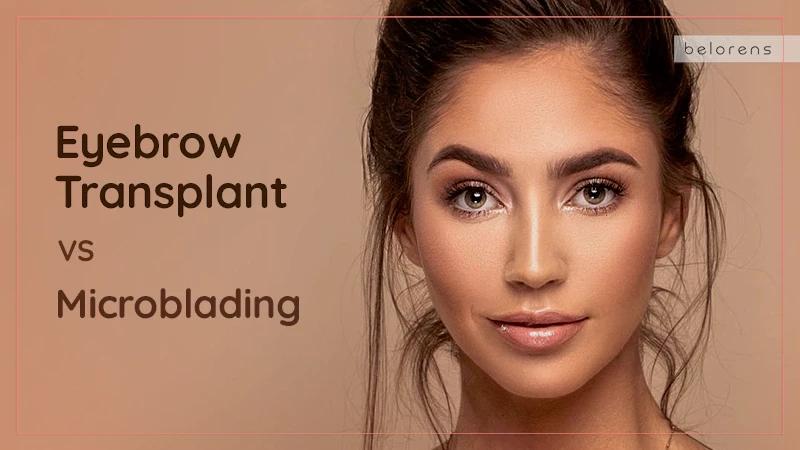Published on 8 Jan 2024 | Last updated on 26 May 2024
Hairline Lowering with Hair Transplant vs Scalp Advancement: Everything You Need to Know
- ByMedical Content Team
- Medically Reviewed byDr. Sabine Kulhanek
Fact checked

People unhappy with their forehead size (whether it’s natural or caused by a receding hairline) and looking for options to reduce their high foreheads have two main options: hair transplantation and scalp advancement. However, the difference between these procedures may not be quite clear for many of them. In this article, we will go through a full comparison of surgical hairline lowering and forehead hair transplantation. But before that, let’s get to know how they’re related and what they have to do with forehead reduction.
Why forehead reduction?
A forehead is a space between the eyebrows and the hairline. And while it could vary a bit in size between the two genders (men usually tend to have larger foreheads) or based on other factors such as race and hairline shape, the normal forehead height is about 5 to 6.5 centimeters on average. So, greater height, especially if not proportionate to other facial features, may be considered large and undesirable. While larger foreheads seem to be more common among men, many women are also unhappy with their disproportionately big foreheads, which could be due to hair loss in the hairline area or simply a congenital trait they’re born with.
Regardless of the underlying reason, a large forehead can be corrected through cosmetic procedures. However, depending on whether the large forehead is caused by a receding hairline or is a congenital trait, a forehead hair transplant or surgical scalp advancement may be the better solution for different people.
The final result of both procedures is a reduction in forehead size, one by adding hair grafts to the front of the head and the other through a surgical reduction of the forehead skin. So quite different procedures, but with the rather same result.
Hairline Lowering Using Hair Transplantation vs. Scalp Advancement
If you’re unhappy with the large size of your forehead or suffer from a receding hairline, you’ve been probably looking for ways to solve this issue. And chances are you already run into different terms talking about forehead reduction but you still don’t know which method is right for you.
Hair transplantation and scalp advancement are two standard methods for reducing the height of the forehead. However, each method has its pros and cons so could be more effective for a specific group of candidates.
Lowering Hairline with Hair Transplantation
A hair transplant or hair grafting could be performed in different parts of the head to compensate for the hair loss which usually occurs due to a hereditary condition in both men and women. Hair loss may happen in different patterns affecting the hairline or crown of the head or result in patchy bald spots.
You could also take advantage of a hair transplant to treat your baldness or change a patchy beard into a full one. But when it comes to the hairline area, a hair transplant could also work as a method to reduce the forehead size by lowering the receding hairline and covering a part of the forehead.
Hair transplantation to lower the hairline is done just like a regular hair transplant procedure in which the hair follicles are harvested from another part of the patient’s head, usually the back of the head, and then transplanted into the frontal part of the head.
Who is the best candidate for lowering hairline with hair transplantation?
Hair transplantation is a common method for lowering the hairline, mostly preferred by people who have weak hair at their hairline, don’t like their hairline pattern, or suffer from an uneven hairline. However, to get effective results you should wait so that your hair loss process ends or else you won’t get the result you’re looking for and you may need to go for a second procedure.

Yet, it could also be beneficial for another group, those with naturally high foreheads. Although they don’t have thin hairs at the hairline and may be satisfied with their hairline shape, the final result is a narrower forehead.
Hair transplant pros and cons
The advantages and disadvantages of a method can help you make an informed decision about a procedure you may take in the future. Let’s start with the advantages:
- No scar: The most important advantage of this method is that there remains no scar on the forehead. However, if you go for the FUT method, a linear scar will be left at the donor site, where the hair grafts are removed. But in FUE, there’ll be no scar on the donor area or the recipient site.
- New hairline shape: Another advantage of hair lowering through hair grafting is the option to correct or reshape the hairline if you don’t like yours. You can ask your doctor to remove a round hairline to create a v-shaped one or vice versa.
Also Read: Comparison of FUT and FUE
So what are the disadvantages?
- Time-taking: You need to be patient because the results won’t show up immediately. You should wait about six weeks to see the initial results and much more, about 18 months, to see the final results.
- Can’t be done during the hair loss process: This downside of hairline lowering through hair transplant was already mentioned. You can’t expect satisfactory results if you get the transplantation while you are still in the middle of the hair loss process.
Hairline lowering using scalp advancement
Surgical scalp advancement, which is also called forehead reduction, hairline lowering, forehead lowering, foreheadplasty, and hairline advancement is another method that helps with correcting a disproportionately large forehead.
Skin elasticity is an important factor in determining if you are a good candidate for this method. In this technique, the surgeon makes an incision along the hairline, from temple to temple, removes a portion of the forehead skin, and then pulls down the scalp skin to meet the other part (this is where elasticity comes to play a role) and stitches them together using surgical sutures.
So if your surgeon does a small pinch test to examine your skin elasticity beforehand, don’t freak out.
Who is the best candidate for hairline lowering using scalp advancement?

Scalp advancement is a great option for women who don’t have a family history of hair loss. However, men could also benefit from this method. People who have thick hair at the hairline, are happy with their hairline shape, and just want to reduce their forehead size could go for this method.
Many MTF transgenders may consider having a surgical forehead reduction as a part of their facial feminization journey so that their forehead size will better match their feminine look.
Also Read: How to Treat Hair Loss in Women
Scalp advancement pros and cons
Just like any other method, hairline lowering using a surgical scalp advancement technique has also its pros and cons. Let’s start with the advantages:
- Quick results: In contrast to hair transplant, the best advantage of scalp advancement is that it is a very fast method. You can see the result as soon as the surgery is done.
- You don’t have to wait for the hair loss to stop: So again, it kind of contributes to the faster result. Since you also don’t have to wait a long time to make sure you’re not losing hair anymore.
If you pass the skin elasticity test, there remains not much limitation. However, there’s one disadvantage to this method:
- Scars: The main disadvantage of this method is the scarring since there’s a long incision involved, which usually leaves some visible scars around the hairline area. However, the scar could be more or less hidden within the hairline depending on several factors, including the healing quality, the surgeon’s expertise, and the patient’s hairstyle.
Is There a Better Option for Reducing the Forehead Size?
Well, considering these two methods' pros and cons, you can go for the best option. An ideal solution would be to have both procedures. The scalp advancement lowers the hairline while the transplant places additional hair strands within the hairline to increase the hair density and better conceal the future — as well as to create a sharply defined hairline. Your surgeon can decide whether you can do both procedures at once or give it a few months after scalp advancement surgery to have the hair transplant procedure.
Summery
In conclusion, when considering forehead reduction, individuals have two main options: hairline lowering through hair transplantation and scalp advancement. The choice depends on factors such as hairline pattern, hair density, and skin elasticity. Consulting with a qualified surgeon is crucial to determine the best procedure or a combination of both for optimal results. It's important to have realistic expectations and understand the potential risks and benefits. Ultimately, these procedures offer effective solutions to reduce forehead size and enhance one's confidence in their appearance.



